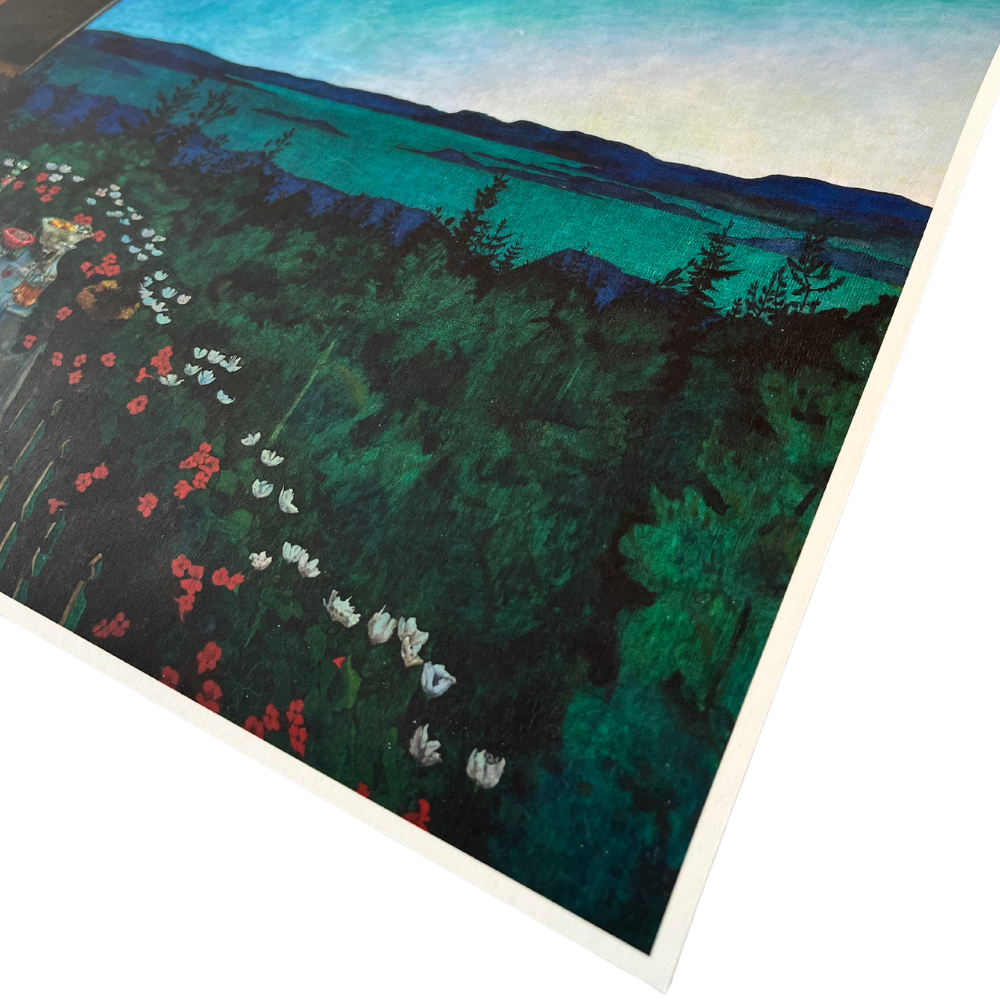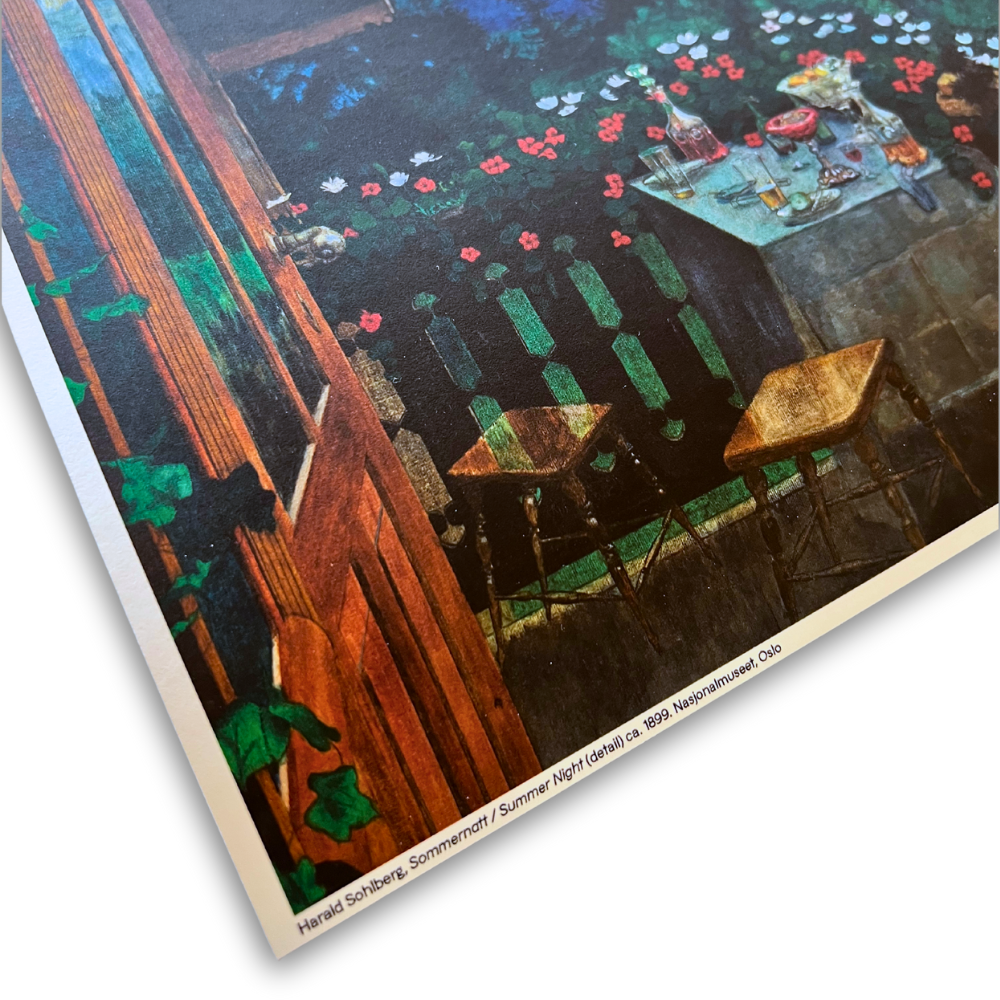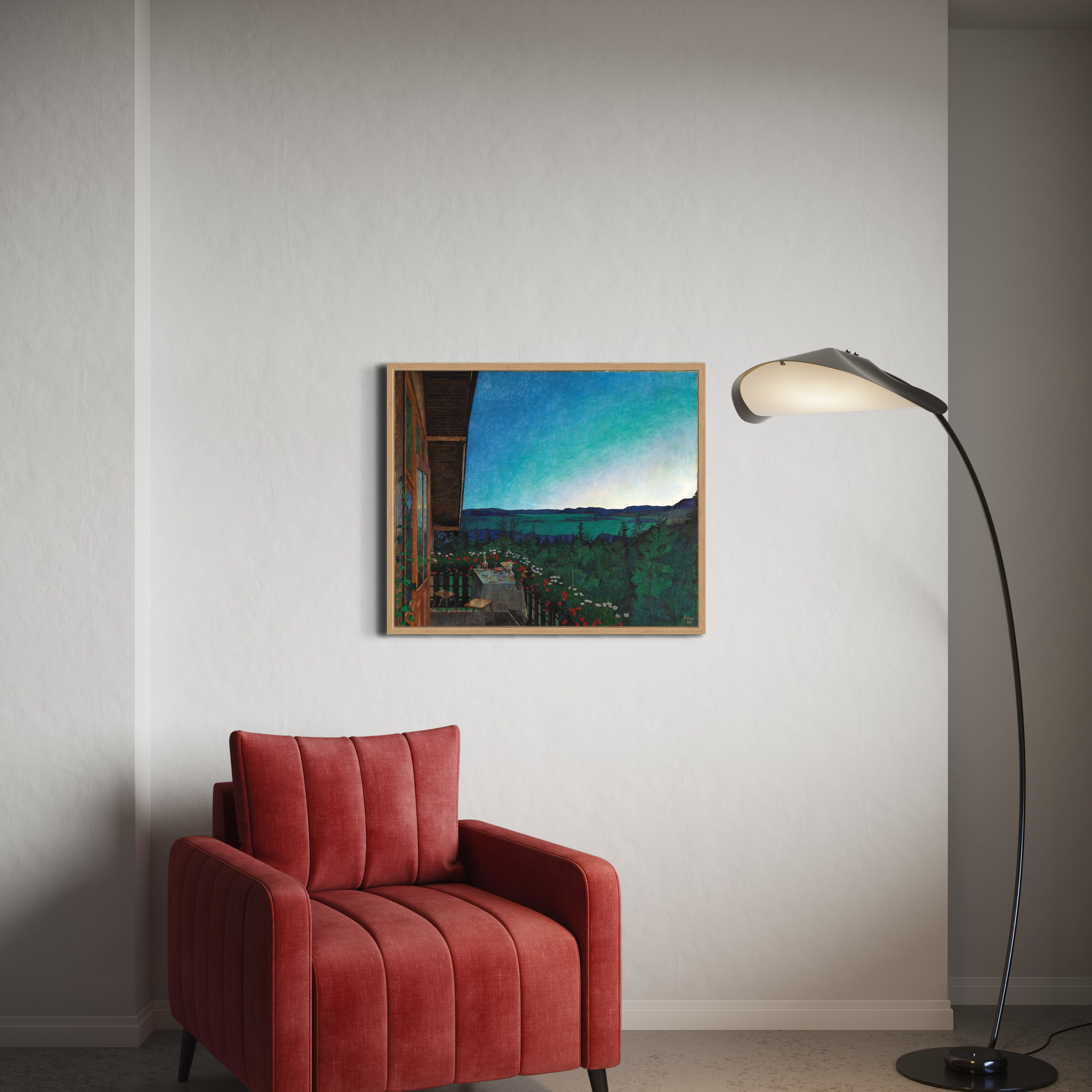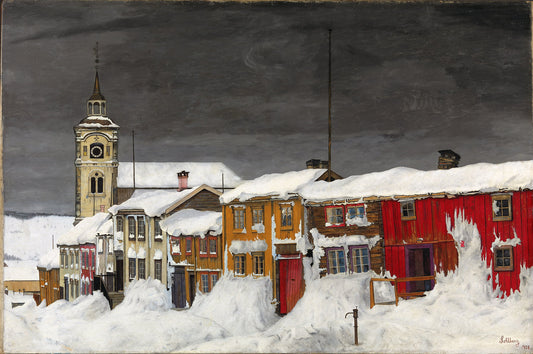Harald Sohlberg
Summer night
Summer night
Couldn't load pickup availability
Experience museum-quality art from the National Museum's collection! Our Posters are printed on premium quality Litho White Matt (230 g) photo paper and feature a visible National Museum logo on the white border. Artprints are produced on exclusive Museum Rag (260 g) cotton art paper for an extra luxurious finish. Each print is made to order by Dáidda Printlab to ensure the highest quality and detail in the reproduction.
About the original:
The oak stools have been carelessly pushed aside and the people have probably gone indoors. The veranda door is still ajar and reflects the landscape in the window glass. There are half-empty glasses and decanters on the table, and a pair of ladies' gloves and a hat have been left on the flower box. The greatly shortened house wall and the colorful diagonal of flowers create a perspectival impression in the motif. Attention is drawn to the dark silhouettes of the landscape and the brighter evening sky in the distance. The motif contains a tension between the foreground's colorful richness of detail and the background's simplification in both form and colour.
The painting can be considered an atmospheric tribute to the bright, Nordic summer night. At the same time, it expresses a strong, almost cosmic experience of an infinite sky above the undulating ridgeline. The artist possibly also wanted to convey the feeling of silence and solitude that can rest over a landscape. As so often in Harald Sohlberg's pictures, people are absent.
At the time when the picture was painted, Sohlberg lived in a small apartment in the residential area of Nordstrand in Kristiania, with a view of the islands in the inner Kristianiafjord and the Bærumsås islands. For him himself, Sommernatt was linked to his own biography – the picture celebrates his engagement. Sohlberg's thoughts were put into written form if the motif is then also linked to love, coexistence and anticipatory joy.
Text: Frithjof Bringager
From "Highlights. Art from Antiquity to 1945", The National Museum 2014, ISBN 978-82-8154-084-2
Date: 1899
Other titles: Summer Night (ENG)
Designation: Painting
Material and technique: oil on canvas
Technique: Oil
Material: Canvas
Dimensions: 114 x 135.5 cm
Subject: Visual arts
Classification: 532 - Visual arts
Motif: Summer
Type of motif: Landscape
Motif - place: Nordstrand, Oslo
Acquisition: Purchased 1899
Inventory no.: NG.M.00525
Part of exhibition: Art 3. Works from the collection 1814-1950, 2007 - 2011
The dance of life. The collection from antiquity to 1950, 2011 - 2019
Edvard Munch and Harald Sohlberg. Landscape of the Mind, 1996
Im Lichte des Nordens. Scandinavian Painting at the Turn of the Century, 1986 - 1987
Dreams of a summer night. Scandinavian painting at the turn of the century, 1986
Nordic Art. The Modern Breakthrough 1860-1920, 2012 - 2013
Edvard Munch and Harald Sohlberg. Landscapes of the Mind, 1995 - 1996
Landschaft als Kosmos der Soule. Malerei des nordischen Symbolismus bis Munch, 1998
Nordic moods. Nordic painting at the turn of the century, 1987
Registration level: Single object
Owner and collection: The National Museum of Art, Architecture and Design, Visual Art Collections
Photo: Høstland, Børre
Delivery
Delivery
Pickup: You can pick up your package from us shortly. You will receive a pickup notification when it is ready.
Postal shipment: Delivery by Posten normally takes 2–5 days in Norway and up to 14 days to Europe and globally.
Packaging: All products are made to order and shipped rolled in environmentally friendly packaging.





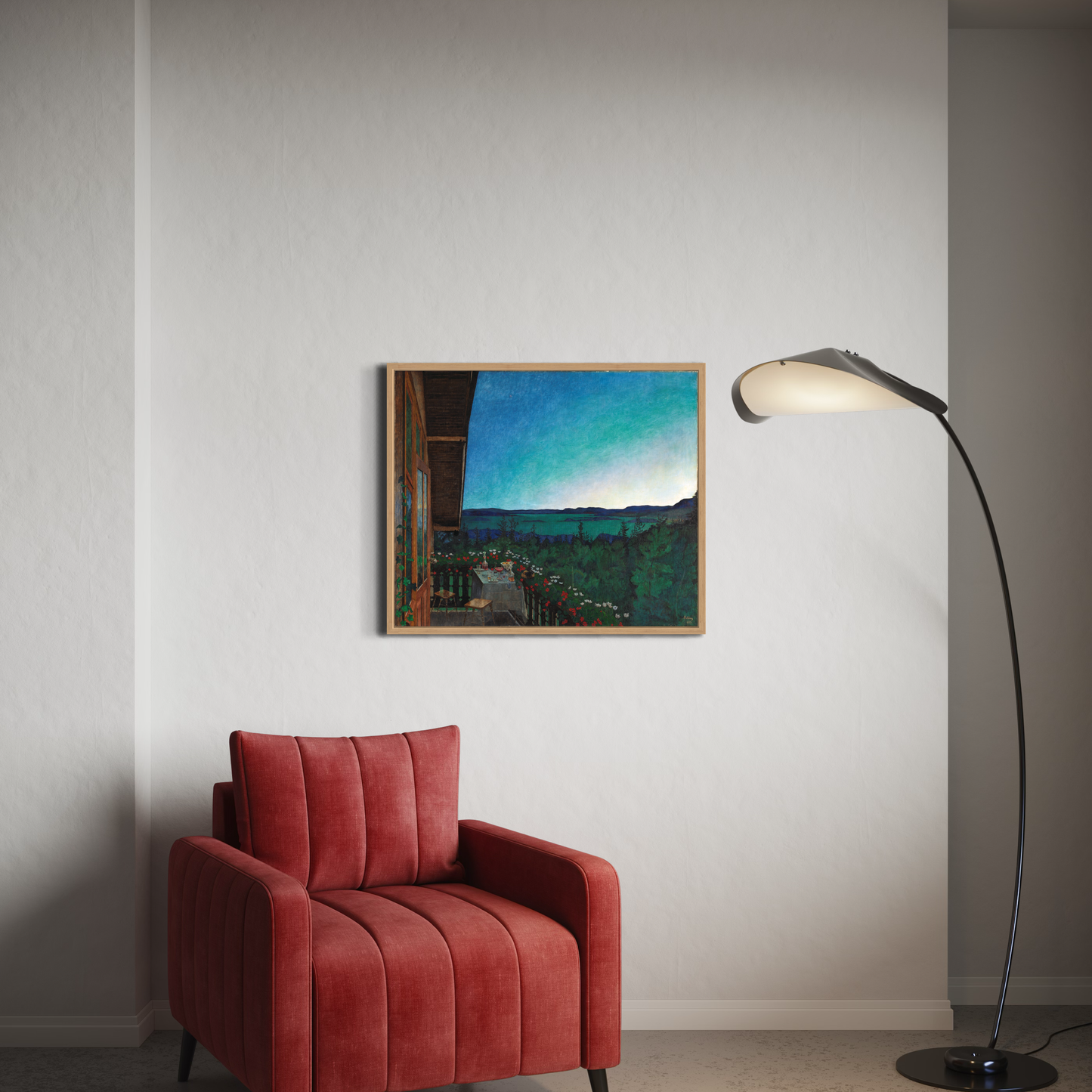
See all works
-
Winter night in Rondane
Vendor:Harald SohlbergRegular price From 150,00 NOKRegular priceUnit price per -
Summer night
Vendor:Harald SohlbergRegular price From 150,00 NOKRegular priceUnit price per -
Street in Røros
Vendor:Harald SohlbergRegular price From 150,00 NOKRegular priceUnit price per -
A flower meadow to the north
Vendor:Harald SohlbergRegular price From 150,00 NOKRegular priceUnit price per
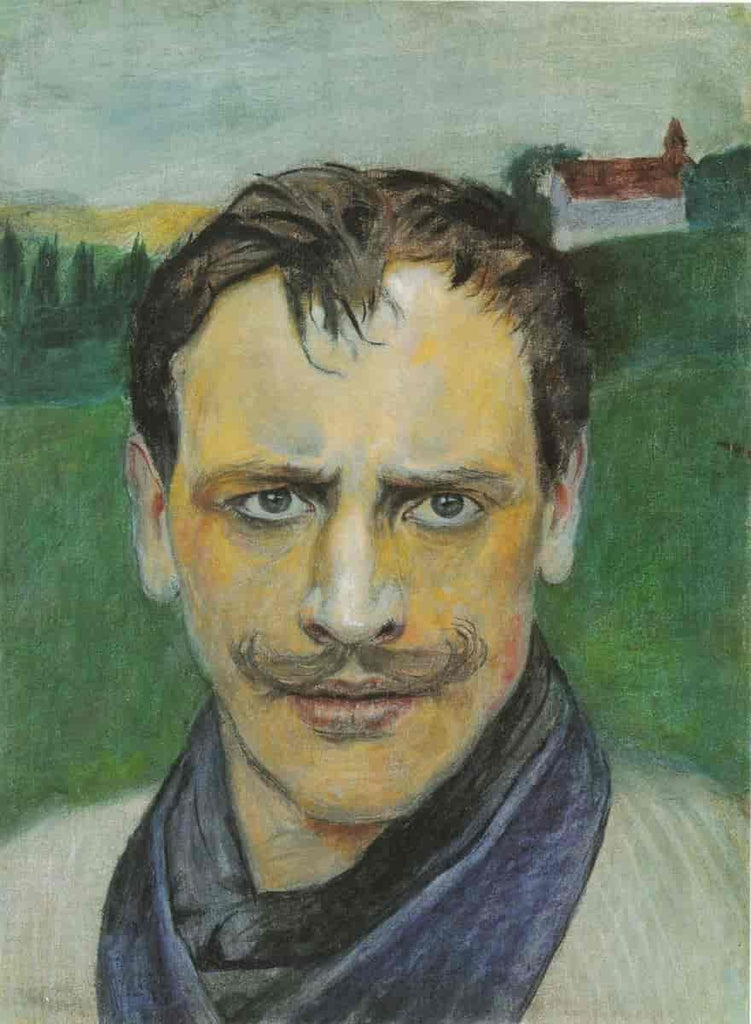
Harald Sohlberg
Harald Sohlberg was a Norwegian painter who was central to the breakthrough of neo-romanticism in Norway. He was born in Oslo and had a very distinctive style where he placed great emphasis on drawing and details, while at the same time the pictures were not pure imitations of nature. Sohlberg sought to express his experiences of nature and adapted drawing and colors so that the pictures could convey these experiences. The symmetrical composition he used in many of the pictures helps to bring in a supernatural, almost religious atmosphere.
Education
Sohlberg began his artistic education at the Royal School of Arts and Crafts in 1885, where he was a student up to and including the autumn of 1890. He also had a stay in Slagen by Åsgårdsstrand in 1890, where he was a student of Sven Jørgensen. He then studied under Kristian Zahrtmann in Copenhagen in 1891–1892 and drew for four months at Eilif Peterssen's and Harriet Backer's painting school in 1894.
Known for mood pictures
Sohlberg traveled to Valdres to paint in the summer of 1889, and there he painted a study called Summer evening, a picture with broad brushstrokes and violet tones that emphasize the evening atmosphere. The picture links to the summer night pictures that Kitty Kielland and Eilif Peterssen had painted by Dælivannet in 1886, and shows the interest in conveying the mood of nature which was to become Sohlberg's main interest in the following years.
In 1894, Sohlberg made his debut at the Statens Kunstutstilling (Autumn Exhibition) with the picture Nattegloð (1893), which was to be his artistic breakthrough and was purchased for the National Gallery. The picture has many of the distinctive features and qualities that were to become a hallmark of Sohlberg's art. In 1899, Sohlberg painted Sommernatt, a picture from Nordstrand with a view over the Oslofjord. Sohlberg has sought here to capture the special atmosphere of the Norwegian summer night, and he stylizes the landscape in clean surfaces and clear lines.
Sohlberg is particularly known for atmospheric images such as Summer Night, the cemetery image Night, Flower meadow north, and not least Winter Night in Rondane. He had a significant influence on Norwegian art in the first half of the 20th century, and his style and motifs have inspired many later Norwegian artists.



